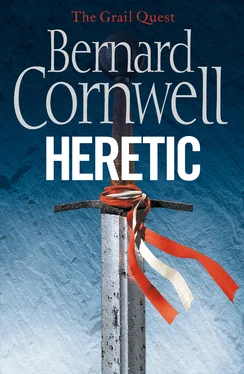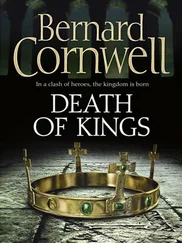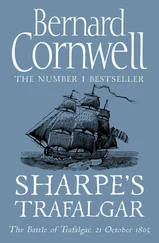Published by HarperCollins Publishers Ltd
1 London Bridge Street
London SE1 9GF
www.harpercollins.co.uk
First published by HarperCollins Publishers 2004
Copyright © Bernard Cornwell 2004
Bernard Cornwell asserts the moral right to be identified as the author of this work
A catalogue record for this book is available from the British Library
This novel is entirely a work of fiction. The names, characters and incidents portrayed in it are the work of the author’s imagination. Any resemblance to actual persons, living or dead, events or localities is entirely coincidental.
All rights reserved under International and Pan-American Copyright Conventions. By payment of the required fees, you have been granted the non-exclusive, non-transferable right to access and read the text of this ebook on-screen. No part of this text may be reproduced, transmitted, down-loaded, decompiled, reverse engineered, or stored in or introduced into any information storage and retrieval system, in any form or by any means, whether electronic or mechanical, now known or hereinafter invented, without the express written permission of HarperCollins ebooks
HarperCollins Publishers has made every reasonable effort to ensure that any picture content and written content in this ebook has been included or removed in accordance with the contractual and technological constraints in operation at the time of publication
Source ISBN: 9780007310326
Ebook Edition © JULY 2009 ISBN: 9780007338801
Version: 2018-04-20
‘The battle scenes, as always, are masterful; and the vignettes of everyday living, in times of extreme hardship, have the ring of simple truth’
Sunday Telegraph
HERETIC
is for Dorothy Carroll,
who knows why
CONTENTS
Cover
Title Page
Copyright Copyright Published by HarperCollins Publishers Ltd 1 London Bridge Street London SE1 9GF www.harpercollins.co.uk First published by HarperCollins Publishers 2004 Copyright © Bernard Cornwell 2004 Bernard Cornwell asserts the moral right to be identified as the author of this work A catalogue record for this book is available from the British Library This novel is entirely a work of fiction. The names, characters and incidents portrayed in it are the work of the author’s imagination. Any resemblance to actual persons, living or dead, events or localities is entirely coincidental. All rights reserved under International and Pan-American Copyright Conventions. By payment of the required fees, you have been granted the non-exclusive, non-transferable right to access and read the text of this ebook on-screen. No part of this text may be reproduced, transmitted, down-loaded, decompiled, reverse engineered, or stored in or introduced into any information storage and retrieval system, in any form or by any means, whether electronic or mechanical, now known or hereinafter invented, without the express written permission of HarperCollins ebooks HarperCollins Publishers has made every reasonable effort to ensure that any picture content and written content in this ebook has been included or removed in accordance with the contractual and technological constraints in operation at the time of publication Source ISBN: 9780007310326 Ebook Edition © JULY 2009 ISBN: 9780007338801 Version: 2018-04-20
Praise ‘The battle scenes, as always, are masterful; and the vignettes of everyday living, in times of extreme hardship, have the ring of simple truth’ Sunday Telegraph
Dedication HERETIC is for Dorothy Carroll, who knows why
Prologue:CALAIS, 1347 PROLOGUE Calais, 1347
Part One:THE DEVIL’S PLAYTHING PART ONE The Devil’s Plaything
The Count of …
It had not …
Thomas spent his …
Thomas and his …
In the name …
Part Two: FUGITIVE
It rained all …
Thomas woke with …
Sir Henri Courtois …
Part Three: THE DARKNESS
The search of …
Sir Guillaume, the …
It was on …
Epilogue: THE GRAIL
Historical Note
Keep Reading
About the Author
Also by Bernard Cornwell
About the Publisher
The road came from the southern hills and crossed the marshes by the sea. It was a bad road. A summer’s persistent rain had left it a strip of glutinous mud that baked hard when the sun came out, but it was the only road that led from the heights of Sangatte to the harbours of Calais and Gravelines. At Nieulay, a hamlet of no distinction whatever, it crossed the River Ham on a stone bridge. The Ham was scarcely worth the title of river. It was a slow stream that oozed through fever-ridden marshlands until it vanished among the coastal mudflats. It was so short that a man could wade from its source to the sea in little more than an hour, and it was so shallow that a man could cross it at low tide without getting his waist wet. It drained the swamps where reeds grew thick and herons hunted frogs among the marsh grass, and it was fed by a maze of smaller streams where the villagers from Nieulay and Hammes and Guîmes set their wicker eel traps.
Nieulay and its stone bridge might have expected to slumber through history, except that the town of Calais lay just two miles to the north and, in the summer of 1347, an army of thirty thousand Englishmen was laying siege to the port and their encampment lay thick between the town’s formidable walls and the marshes. The road which came from the heights and crossed the Ham at Nieulay was the only route a French relief force might use and in the height of the summer, when the inhabitants of Calais were close to starvation, Philip of Valois, King of France, brought his army to Sangatte.
Twenty thousand Frenchmen lined the heights, their banners thick in the wind blowing from the sea. The oriflamme was there, the sacred war pennant of France. It was a long flag with three pointed tails, a blood-red ripple of precious silk, and if the flag looked bright that was because it was new. The old oriflamme was in England, a trophy taken on the wide green hill between Wadicourt and Crécy the previous summer. But the new flag was as sacred as the old, and about it flew the standards of France’s great lords: the banners of Bourbon, of Montmorency and of the Count of Armagnac. Lesser flags were visible among the noble standards, but all proclaimed that the greatest warriors of Philip’s kingdom were come to give battle to the English. Yet between them and the enemy were the River Ham and the bridge at Nieulay that was defended by a stone tower around which the English had dug trenches. These they had filled with archers and men-at-arms. Beyond that force was the river, then the marshes, and on the higher ground close to Calais’s high wall and its double moat was a makeshift town of houses and tents where the English army lived. And such an army as had never been seen in France. The besiegers’ encampment was bigger than Calais itself. As far as the eye could see were streets lined with canvas, with timber houses, with paddocks for horses, and between them were men-at-arms and archers. The oriflamme might as well have stayed unfurled.
‘We can take the tower, sire.’ Sir Geoffrey de Charny, as hard a soldier as any in Philip’s army, gestured down the hill to where the English garrison of Nieulay was isolated on the French side of the river.
‘To what end?’ Philip asked. He was a weak man, hesitant in battle, but his question was pertinent. If the tower did fall and the bridge of Nieulay was thus delivered into his hands, what would it serve? The bridge merely led to an even greater English army, which was already arraying itself on the firm ground at the edge of its encampment.
Читать дальше












